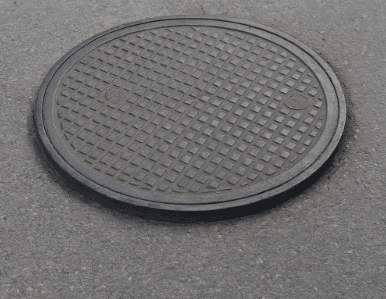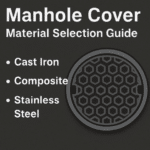Manhole cover maintenance is an essential part of urban infrastructure management, especially in cities with aging sewer, drainage, and utility systems. Daily maintenance costs often include inspections, repairs, replacements, and emergency responses caused by traffic damage, corrosion, and environmental exposure. As municipalities seek more cost-effective solutions, understanding how to reduce ongoing maintenance expenses becomes increasingly important.
1. Choose Durable Materials to Reduce Long-Term Maintenance Costs
Selecting the right materials is one of the most effective ways to reduce manhole cover maintenance costs. Traditional gray cast iron has been widely used due to its durability, but newer material technologies offer improved performance and lower maintenance requirements.
High-strength ductile iron, for example, provides greater load resistance and is less prone to cracking under heavy traffic. Composite materials are lightweight, corrosion-resistant, and theft-proof, making them ideal for urban areas where environmental exposure and vandalism are concerns. Stainless steel covers, though used less frequently, offer excellent corrosion protection for coastal regions and chemical environments.
While these premium materials may increase initial purchase costs, they significantly lower long-term expenses by minimizing replacement frequency, surface wear, and emergency repairs.
2. Improve Installation Quality to Prevent Early Failures
Even the strongest manhole cover will fail prematurely if installed incorrectly. Poor installation practices—such as improper leveling, weak bedding material, and insufficient compaction—often lead to rocking covers, cracked frames, and long-term settlement. These problems increase maintenance frequency and raise total lifecycle costs.
To reduce expenses, engineers should ensure that the manhole frame is properly seated in reinforced concrete, road surfaces around the collar are compacted evenly, and the frame aligns precisely with the cover. The use of anti-corrosion coatings during installation further protects the frame from moisture and chemical exposure.
By implementing standardized installation procedures, cities can greatly reduce the volume of service calls and extend the overall service life of their infrastructure.
3. Utilize Protective Coatings and Anti-Corrosion Treatments
Corrosion remains one of the leading causes of manhole cover deterioration. Environmental factors such as humidity, chemicals, salt, and wastewater gases can severely weaken metal surfaces over time. Consequently, applying protective coatings can significantly reduce daily maintenance costs and protect long-term performance.
Epoxy, polyurethane, and zinc-rich coatings are commonly used to protect metal components from rust, while hot-dip galvanizing adds a highly durable barrier for steel frames. For areas with extreme conditions—such as coastal cities or industrial zones—composite overlays or rubber linings provide additional protection.
These coatings reduce the likelihood of structural damage, minimize the need for frequent inspections, and extend the lifespan of both covers and frames, resulting in lower routine maintenance spending.
4. Implement Smart Monitoring and Predictive Maintenance Systems
Smart infrastructure technologies have transformed the way municipalities manage manhole cover maintenance. Modern IoT sensors allow continuous monitoring of vibration, load, displacement, and unauthorized opening, enabling operators to identify problems before they escalate into costly repairs.
Predictive maintenance systems reduce unnecessary manual inspections, improve response efficiency, and automatically alert technicians when a cover becomes unstable or starts to settle. By acting early, cities can avoid major failures and reduce emergency repair expenses.
Although the upfront cost of installing sensors may be higher, the long-term savings are substantial—especially in dense urban areas with hundreds of manhole covers.
5. Reinforce Structures in High-Traffic Areas
Heavy traffic, especially from buses, trucks, and industrial vehicles, is a major cause of manhole cover wear and settlement. When load distribution is uneven, frames may crack, covers may deform, and road surfaces may deteriorate quickly, leading to frequent maintenance requirements.
To reduce daily maintenance costs in these high-load environments, cities should use heavy-duty load ratings such as D400 or F900, install reinforced frames, and implement anti-vibration seating systems. Flexible elastomer seals can absorb shock and prevent noise, while reinforced concrete collars distribute weight more evenly across the surrounding pavement.
By strengthening the structure, municipalities can avoid repeated repairs, reduce safety risks, and extend the usable lifespan of their manhole systems.
6. Apply a Preventive Maintenance Strategy Instead of Reactive Repairs
Preventive maintenance is often far more cost-effective than responding to failures after they occur. A structured preventive plan can include routine inspections, cleaning debris around covers, lubricating hinges, checking frame alignment, and identifying early signs of corrosion or settlement.
Preventive maintenance reduces the risk of sudden failure, minimizes emergency crew deployment, and ensures smoother urban traffic flow. In addition, recording data from inspections helps identify long-term performance trends and areas with recurring problems.
By shifting from reactive repairs to proactive planning, cities can drastically reduce annual maintenance costs while improving infrastructure reliability.
Conclusion
Reducing the daily maintenance costs of manhole covers requires a combination of engineering best practices, modern technologies, proper material selection, and smart asset management strategies. By focusing on durability, installation quality, corrosion prevention, predictive maintenance, structural reinforcement, and preventive care, municipalities and utility companies can significantly extend the lifespan of their manhole covers while cutting long-term costs.
Through thoughtful planning and investment, urban infrastructure becomes safer, more resilient, and economically sustainable. Effective manhole cover maintenance is not only about cost savings—it is also an essential part of creating safer, more efficient cities for future generations.
FAQ (Frequently Asked Questions)
1. Why is manhole cover maintenance so costly?
Maintenance involves inspections, repairs, corrosion control, and replacements. High traffic load, poor installation, and environmental exposure increase costs significantly.
2. How often should municipalities inspect manhole covers?
Most cities conduct inspections every 6–12 months, while high-traffic areas may require quarterly checks to detect settlement or structural issues early.
3. Do composite manhole covers reduce maintenance expenses?
Yes. Composites are corrosion-resistant, lightweight, and theft-proof, leading to lower replacement frequency and reduced labor requirements.
4. Can smart monitoring systems help lower maintenance budgets?
Smart sensors detect early damage, reduce unnecessary inspections, and prevent emergencies—resulting in long-term cost savings.
5. What is the longest lifespan a manhole cover can achieve with proper maintenance?
High-quality covers with preventive maintenance can last 20–30 years, depending on traffic load and environmental conditions.





